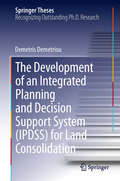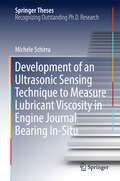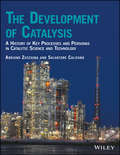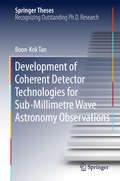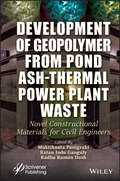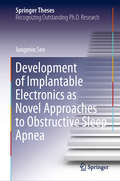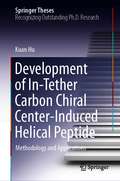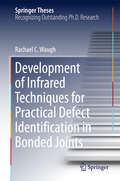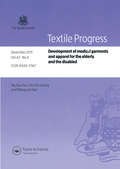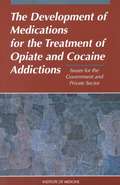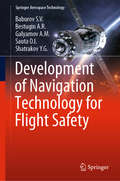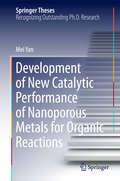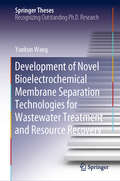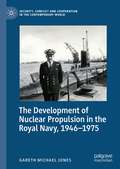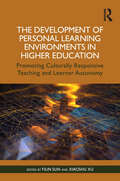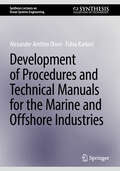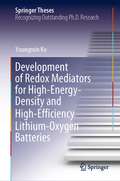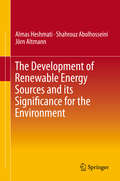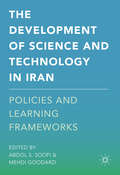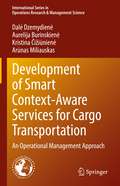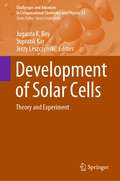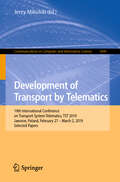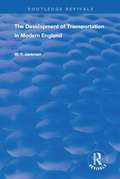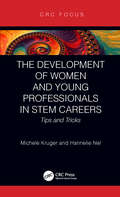- Table View
- List View
The Development of an Integrated Planning and Decision Support System (IPDSS) for Land Consolidation
by Demetris DemetriouThis book provides an extensive review of three interrelated issues: land fragmentation, land consolidation, and land reallocation, and it presents in detail the theoretical background, design, development and application of a prototype integrated planning and decision support system for land consolidation. The system integrates geographic information systems (GIS) and artificial intelligence techniques including expert systems (ES) and genetic algorithms (GAs) with multi-criteria decision methods (MCDM), both multi-attribute (MADM) and multi-objective (MODM). The system is based on four modules for measuring land fragmentation; automatically generating alternative land redistribution plans; evaluating those plans; and automatically designing the land partitioning plan. The presented research provides a new scientific framework for land-consolidation planning both in terms of theory and practice, by presenting new findings and by developing better tools and methods embedded in an integrated GIS environment. It also makes a valuable contribution to the fields of GIS and spatial planning, as it provides new methods and ideas that could be applied to improve the former for the benefit of the latter in the context of planning support systems. "From the 1960s, ambitious research activities set out to observe regarding IT-support of the complex and time consuming redistribution processes within land consolidation - without any practically relevant results, until now. This scientific work is likely to close that gap. This distinguished publication is highly recommended to land consolidation planning experts, researchers and academics alike. " - Prof. Dr. -Ing. Joachim Thomas, Münster/ Germany "Planning support systems take new scientific tools based on GIS, optimisation and simulation and use these to inform the process of plan-making and policy. This book is one of the first to show how this can be consistently done and it is a triumph of demonstrating how such systems can be made operational. Essential reading for planners, analysts and GI scientists. " - Prof. Michael Batty, University College London
Development of an Ultrasonic Sensing Technique to Measure Lubricant Viscosity in Engine Journal Bearing In-Situ
by Michele SchirruThis thesis presents a novel ultrasonic instrument for non-invasive and in-situ characterization of journal bearing lubricant viscosity. In particular, the application to journal bearings is described by non-invasively measuring the viscosity and localized power losses throughout operation. This ultrasonic viscometer is based on the reflection of polarized shear waves from a thin resonating coating layer to increase the measurement sensitivity, in comparison to conventional ultrasonic methods. This instrument allows for a full engine oil viscoelastic characterization in-situ. The book investigates the effects of temperature, pressure and shear rate, and describes in detail the ultrasonic setup and method. Further, it demonstrates that the same technique can be applied similarly to monitor the lubrication of other engine components. As such, it offers a unique instrument that can drive the research of oil formulations to improve engine performance and fulfill the requirements of international fuel economy regulations.
The Development of Catalysis: A History of Key Processes and Personas in Catalytic Science and Technology
by Adriano Zecchina Salvatore CalifanoThis book gradually brings the reader, through illustrations of the most crucial discoveries, into the modern world of chemical catalysis. Readers and experts will better understand the enormous influence that catalysis has given to the development of modern societies.• Highlights the field's onset up to its modern days, covering the life and achievements of luminaries of the catalytic era• Appeals to general audience in interpretation and analysis, but preserves the precision and clarity of a scientific approach• Fills the gap in publications that cover the history of specific catalytic processes
Development of Coherent Detector Technologies for Sub-Millimetre Wave Astronomy Observations
by Boon-Kok TanThe thesis describes the development of receiver technologies for sub-millimetre astronomy instruments, focusing on high performance coherent cryogenic detectors operating close to the superconductor gap frequency. The mixer chip which comprises the SIS devices, fed by a unilateral finline and matching planar circuits was fabricated on 15 micron silicon substrate using the recently developed Silicon-On-Insulator (SOI) technology. This offered broadband IF and RF performance, with fully integrated on-chip planar circuits resulting in an easily reproducible mixer chip and a simple mixer block. An important consequence of this design is that it can be extended to the supra-THz region and making the fabrication of multi-pixel heterodyne arrays feasible. The extension of the operation of major telescopes such as ALMA, APEX and the GLT from single pixel to large format arrays is the subject of extensive research at present time since it will allow fast mapping combined with high resolution of the submillimetre sky. The technology described in this thesis makes a major contribution to this effort.
Development of Geopolymer from Pond Ash-Thermal Power Plant Waste: Novel Constructional Materials for Civil Engineers
by Muktikanta Panigrahi Ratan Indu Ganguly Radha Raman DashDEVELOPMENT OF GEOPOLYMER FROM POND ASH-THERMAL POWERPLANT WASTE Explains how geopolymer technologies using industrial waste obtained from thermal power plants become cementitious materials in construction sectors for civil engineers. Utilization of waste materials has become a global challenge since they endanger our environment. In this book, the authors demonstrate how to utilize fly ash/pond ash (waste materials from thermal power plants) to produce a novel material called ‘Geopolymer’ (GP). Red mud, slags, etc., are mixed with fly ash to produce GP with enhanced strength. As shown in a few European countries, GP can replace cement, and some permanent structures constructed with GP are now appearing in a few advanced countries. GP, and geopolymer concrete, is considered suitable for the construction of roads, buildings, etc., and will eventually, fully or partially, replace cement. The book highlights the mechanism of the formation of GP from pond ash. Properties of structures made with GP concrete are found to be comparable to those made with cement concrete. Systematic investigations are presented to understand the chemistry of GP formation with pond ash materials. Performances of these materials above ambient temperature, as well as with different environmental conditions, are also evaluated.
Development of Implantable Electronics as Novel Approaches to Obstructive Sleep Apnea (Springer Theses)
by Jungmin SeoThis book addresses novel methods to treat a very popular disease, obstructive sleep apnea, based on a knowledge of an electrical engineering. Two approaches are given in the book using an upper-airway stimulation based on the pathogenesis of an obstructive sleep apnea. Implantable electronics are devised to control the tongue and the soft palate considering that they are the major pharyngeal muscles contributing to the apnea. First, for tongue control, a cuff electrode was designed and fabricated to stimulate the hypoglossal nerve, which innervates to the tongue muscle. Rare-earth magnets were embedded in the cuff for easy and repeatable installation of the electrode. For soft palate control, a palatal implant system was firstly developed to contract the soft palate muscle by applying electrical stimuli. Comprised of an implant, an intra-oral device, and an external controller, the palatal implant system is fully powered and controlled by means of wireless communication. The approaches were demonstrated in both in vitro and in vivo assessments, in collaboration with department of Otorhinolaryngology, Seoul National University Bundang Hospital.
Development of In-Tether Carbon Chiral Center-Induced Helical Peptide: Methodology and Applications (Springer Theses)
by Kuan HuThis book focuses on the development of stapled peptides, a novel molecular modality used to regulate aberrant intracellular protein–protein interactions (PPIs). The author designs and presents a novel helical peptide stabilization methodology by constructing a chiral cross-linker moiety, namely “chiral center induced peptide helicity (CIH)”. The book demonstrates that a precisely positioned carbon chiral center on tether can decisively determine the secondary structure of a peptide, and that the R-configured peptide is helical, while the S-configured peptide is non-helical. Further, it reports that helicity-enhanced R isomer peptides displayed significantly enhanced cell permeability and target binding affinity, as well as tumor inhibition efficiency, in comparison to S isomer peptides. The book will not only advance readers’ understanding of the basic principle of stapled peptides, but also accelerate the clinical transformation of stapled peptide drugs.
Development of Infrared Techniques for Practical Defect Identification in Bonded Joints
by Rachael C. WaughMaximizing reader insights into the use of thermography, specifically pulsed and pulse phase thermography (PT and PPT), for the identification of kissing defects in adhesive bonds, this thesis focuses on the application of PT and PPT for the identification of a range of defect types in a variety of materials to establish the effect of material properties on identification of defects. Featuring analysis of a numerical model developed to simulate the thermal evolution created during a PT or PPT experiment, after validation through a series of case studies, this model is then used as a predictive tool to relate defect detectability to the thermal property contrast between defect and bulk materials. Demonstrating a means of producing realistic kissing defects in bonded joints where insufficient thermal property contrast exists defects have a limited effect on heat propagation through a component and therefore are not detected using PT or PPT, this thesis discusses the addition of a small load to bonds containing kissing defects which was found to open the defects sufficiently to enable their detection. A low cost infrared detector, Flir Tau320, is compared to the research based photon detector, Flir SC5000, and is shown to be suitable for application in PT, thus enabling a significantly lower cost tool to be developed.
Development of Medical Garments and Apparel for the Elderly and the Disabled (Textile Progress Ser.)
by Ng Sau-FunAlthough the main theme of this book is products for the elderly and the disabled, it also contains major sections on medical garments, which include personal protective equipment (PPE), hip protectors (HP), pressure garments (PG), compression stockings (CS), wet dressings, products for wound dressing, adult incontinence products, sanitary napkins, disposable diapers, vital signs monitoring garments, motion aware clothing, wearable sensors and smart diapers and so on. The development of apparel for the elderly and the disabled is a challenge for the healthcare and clothing industries. The developed apparel products are not only based on various design, fashion and comfort concepts but also considered in terms of particular medical problems, restorative care functions, and appropriate solutions for healthcare purposes.
Development of Medications for the Treatment of Opiate and Cocaine Addictions: Issues for the Government and Private Sector
by Committee to Study Medication Development Research at the National Institute on Drug AbusePharmacotherapy, as a means of treating drug addiction in combination with other treatment modalities, has received too little attention from the research community, the pharmaceutical industry, public health officials, and the federal government. Medications to combat drug addiction could have an enormous impact on the medical consequences and socioeconomic problems associated with drug abuse, both for drug-dependent individuals and for American society as a whole. This book examines the current environment for and obstacles to the development of anti-addiction medications, specifically those for treating opiate and cocaine addictions, and proposes incentives for the pharmaceutical industry that would help overcome those obstacles and accelerate the development of anti-addiction medications.
Development of Navigation Technology for Flight Safety (Springer Aerospace Technology)
by Sauta O.I. Shatrakov Y.G. Bestugin A.R. Baburov S.V. Galyamov A.M.This book highlights practical solutions for flight safety improvement techniques, which are currently the focus of the International Civil Aviation Organization (ICAO). It has become clear that, in order to rapidly and significantly improve flight safety, the integrated use of new aeronautical technologies is called for. Considering the size of the aviation fleet, its constant growth and the long service lives of aircraft, new technologies should be adapted both to cutting-edge air navigation systems and to those that have been used for over a decade. Concretely, the book discusses methodological approaches to the construction of ground and on-board avionics that make it possible to achieve improved flight safety using innovative new methods. The proposed approaches are illustrated with real-world examples of e.g. satellite-based navigation systems and enhanced ground proximity warning systems. The book is written for professionals involved in the development of avionics systems, as well as students, researchers and experts in the field of radiolocation, radio navigation and air traffic control, the book will support the development and modeling of radio technical complexes, as well as the analysis of complex radio technical systems.
Development of New Catalytic Performance of Nanoporous Metals for Organic Reactions
by Mei YanIn this thesis, the focus is on the study of new catalytic properties of unsupported nanoporous metals in heterogeneous organic reactions under liquid-phase conditions. The author was the first to fabricate nanoporous copper with tunable nanoporosity and apply it for organic reactions. The catalyst can be reused up to ten times without loss of catalytic activity. In addition, the author developed the highly selective semihydrogenation of alkynes using nanoporous gold as a catalyst for the first time, affording Z-alkenes in 100% selectivity, which cannot be realized by traditional catalysts. All of the results described here will help readers to develop new catalytic performance of nanoporous metals for organic reactions.
Development of Novel Bioelectrochemical Membrane Separation Technologies for Wastewater Treatment and Resource Recovery (Springer Theses)
by Yunkun WangThe most commonly used biological wastewater treatment technologies still have serious technical-economical and sustainability-related limitations, due to their high energy requirements, poor effluent quality, and lack of energy and resource recovery processes. In this thesis, novel electrochemical membrane bioreactors (EMBRs), which take advantage of membrane separation and bioelectrochemical techniques, are developed for wastewater treatment and the simultaneous recovery of energy and resources. Above all, this innovative system holds great promise for the efficient wastewater treatment and energy recovery. It can potentially recover net energy from wastewater while at the same time harvesting high-quality effluent. The book also provides a proof-of-concept study showing that electrochemical control might offer a promising in-situ means of suppressing membrane fouling. Lastly, by integrating electrodialysis into EMBRs, phosphate separation and recovery are achieved. Hence, these new EMBR techniques provide viable alternatives for sustainable wastewater treatment and resource recovery.
The Development of Nuclear Propulsion in the Royal Navy, 1946-1975 (Security, Conflict and Cooperation in the Contemporary World)
by Gareth Michael JonesThis book examines the development of nuclear propulsion in the Royal Navy from the first proposal in 1946 to the start-up of the last core improvement for the first submarine reactor power plant PWR 1 in December 1974. Drawing from unreleased records and archives, the book answers questions around three main themes. Political: what problems were encountered in transferring nuclear knowledge from the USA to the UK in the post-war period, and how much support was there for the development of nuclear propulsion? Military: why was there a requirement to develop nuclear propulsion, and in particular, why submarines? Technical: were the problems associated with nuclear energy fully appreciated, and did the UK have the technical and engineering capability to develop nuclear propulsion? Aside from the political considerations and military motives for developing nuclear propulsion in the Royal Navy, the author focuses on the technical problems that had to be overcome by all participants in the Royal Navy’s development of nuclear propulsion, adding significantly to naval historiography. Providing a critical analysis of the political, technological, operational and industrial issues of introducing nuclear propulsion into the Royal Navy, the author situates his research in the context of the evolving Cold War, changing Anglo-American relations, the end of Empire and the relative decline of British power.
The Development of Personal Learning Environments in Higher Education: Promoting Culturally Responsive Teaching and Learner Autonomy
by Yilin Sun Xiaoshu XuThe Development of Personal Learning Environments in Higher Education explores how today’s knowledge-based, learner-centered virtual platforms, which often limit teaching to a complimentary facilitation role, can compromise with the requirements and regulations of colleges and universities. Personal Learning Environments (PLEs) driven by culturally responsive teaching and learner autonomy represent a shift in the higher education paradigm, but how can scholars, designers, administrators, and faculty ensure effective, institutionally compatible construction and management of these systems? This book offers forward-thinking insights into the variety of student-centered learning interactions, particularly culturally and linguistically responsive pedagogies, that can be integrated into PLEs. Attending to quality assessment rubrics, the nuances of stakeholders’ needs, and theoretically sound frameworks, these cross-cultural, interdisciplinary chapters explore how leaders, instructors, technologists, and learners can form a precise yet flexible ecosystem to fully realize PLEs in which co-created, intercultural narratives yield rich, relevant digital learning experiences.
Development of Procedures and Technical Manuals for the Marine and Offshore Industries (Synthesis Lectures on Ocean Systems Engineering)
by Alexander Arnfinn Olsen Fidaa KarkoriThis book is devoted to the development of procedures and technical manuals for the marine and offshore industries, providing a comprehensive guide to creating clear, effective instructional materials. At the heart of this book is the matter of safety and environmental considerations, ensuring that all documentation aligns with current practices, policies, and regulatory requirements. The chapters cover topics such as the role of instructional materials, writing techniques, the use of graphics, and the processes for verifying, validating, approving, certifying, and implementing these materials. The authors present an expert analysis of how well-written administrative, regulatory, operating, emergency, maintenance, and routine duty procedures can enhance productivity and reduce accidents. Readers will also discover practical insights into managing instructional materials within safety programs. This book is essential for engineers and professionals tasked with developing technical manuals and texts in safety-critical industries. It serves as a valuable reference for academics and students in industrial design and engineering, as well as a textbook for students of marine architecture. Offshore installation managers and senior safety management professionals will find this guide indispensable for ensuring consistency and quality control in their operations.
Development of Redox Mediators for High-Energy-Density and High-Efficiency Lithium-Oxygen Batteries (Springer Theses)
by Youngmin KoThis thesis addresses the introduction of redox mediator into lithium-oxygen batteries to improve their electrochemical performance especially in terms of practical energy density and round-trip efficiency. In chapter 1, basic electrochemistry regarding lithium-oxygen batteries and redox mediators are introduced. In chapter 2 to 4, comprehensive researches including the discovery of a new redox mediator inspired by biological system, the investigation on kinetic property of redox mediator, and the prevention of shuttle phenomenon are introduced, followed by chapter 5 summarizing the contents. This thesis is targeted to students and researchers interested in electrochemistry and energy storage systems.
The Development of Renewable Energy Sources and its Significance for the Environment
by Almas Heshmati Shahrouz Abolhosseini Jörn AltmannThis book analyzes the effects of power generated by renewable energy sources, renewable energy production technologies, energy efficiency, and market regulation of carbon emissions. It elaborates on how these parameters have direct and indirect effects on carbon emission reduction, such as the results of an environmental tax that could directly reduce carbon emissions by decreasing fossil fuel consumption or by stimulating energy savings through technological innovation, as well as how renewable energy sources can affect both economic growth and the environment. In addition to a detailed analysis of the interrelationships between renewable energy consumption, production technology, and market regulation, The Development of Renewable Energy Sources and its Significance for the Environment proposes a model for measuring the effectiveness and results of the interaction between these links. Furthermore, a structure for a marketplace of renewable energy sources is put forward, as well as an outline of the requirements that must be met in order for this market to function. Suitable policy recommendations to enhance the market for renewable energies are also provided.
The Development of Science and Technology in Iran
by Abdol S. Soofi Mehdi GoodarziThis book examines the policies, conducts, and performances of organizations tasked with developing medium and high technologies in Iran. This collection assists readers in understanding the interaction between different players involve in the process of Iran's science, technology, and innovation development in specific technology areas over the last two decades. Chapters from expert contributors are organized into three themed parts: science and technology policy formulation and implementation, outcomes, and evaluation, including recommendations for further development of technological learning in Iran.
Development of Smart Context-Aware Services for Cargo Transportation: An Operational Management Approach (International Series in Operations Research & Management Science #330)
by Dalė Dzemydienė Aurelija Burinskienė Kristina Čižiūnienė Arūnas MiliauskasWith a focus on cargo transportation, this book addresses the development of approaches intended to secure an infrastructure of smart services to support the adaptive implementation of online multi-modal freight transport management processes. It discusses the development of multi-criteria decision-making components and their integration into the multi-layered computer-based information management of intelligent systems. Through detailed descriptions of various components of intelligent transport management systems, the book demonstrates how to develop the services needed in the right place and at the right time, and how to properly adapt to user needs, making necessary interventions to ensure the safety of the transportation process. Further, it describes the main ways to increase the autonomy and efficiency of user-vehicle interaction and shows how Information and Communications Technology (ICT) structural support for current and past situations in AI-based systems can help to anticipate future developments in freight transportation.
Development of Solar Cells: Theory and Experiment (Challenges and Advances in Computational Chemistry and Physics #32)
by Jerzy Leszczynski Supratik Kar Juganta K. RoyThis book presents a comprehensive overview of the fundamental concept, design, working protocols, and diverse photo-chemicals aspects of different solar cell systems with promising prospects, using computational and experimental techniques. It presents and demonstrates the art of designing and developing various solar cell systems through practical examples. Compared to most existing books in the market, which usually analyze existing solar cell approaches this volume provides a more comprehensive view on the field. Thus, it offers an in-depth discussion of the basic concepts of solar cell design and their development, leading to higher power conversion efficiencies. The book will appeal to readers who are interested in both fundamental and application-oriented research while it will also be an excellent tool for graduates, researchers, and professionals working in the field of photovoltaics and solar cell systems.
Development of Sustainable Thermal Insulators from Waste Materials: A Circular Economy Approach (Materials Horizons: From Nature to Nanomaterials)
by Sarika Verma Mohd. Akram Khan A. K. SrivastavaThis book focuses on the major global waste management issues and development of thermal insulating materials by utilizing these wastes. It helps address various global issues like sustainable environment, waste to wealth, waste to resource material, advanced multifunctional material, skill development and employment generation. The book highlights the potentiality and the applicability of various wastes, such as municipal solid waste, agricultural waste, industrial waste, construction waste, textile waste, waste polystyrene, geopolymer, leather rubber waste, other miscellaneous waste to be considered as a resource and its availability and conversion technologies from waste to wealth as thermal insulating materials. It also discusses recent trends, for processing the waste to wealth as a thermally insulating material. This book is a useful guide to researchers and professionals working in the areas of energy storage, sustainable civil engineering, material science and others allied fields.
Development of Transport by Telematics: 19th International Conference on Transport System Telematics, TST 2019, Jaworze, Poland, February 27 – March 2, 2019, Selected Papers (Communications in Computer and Information Science #1049)
by Jerzy MikulskiThis book constitutes selected papers from the 19th International Conference on Transport Systems Telematics, TST 2019, held in Jaworze, near Bielsko-Biala, Poland, in March 2019. The 31 full papers presented in this volume were carefully reviewed and selected from 104 submissions. They were organized in topical sections named: telematics in rail transport; telematics in road transport; telematics in marine transport; telematics in air transport; and general about telematics.
The Development of Transportation in Modern England (Routledge Revivals)
by William T. JackmanPublished in 1962: In offering this work as a modest contribution to our knowledge of the economic development of England from the standpoint of transportation, the author must say, in the first place that he has endeavoured to adhere rigidly to the subject in hand, withour making deviations into collateral fields
The Development of Women and Young Professionals in STEM Careers: Tips and Tricks (CRC Press Focus Shortform Book Program)
by Michele Kruger Hannelie NelThis book is fluent and systematic. The authors work through the fears and ambitions of young people new to STEM careers in the professional environment. Often, there is a lack of mentors, which leaves a young STEM practitioner exposed and doubting their own abilities. This book encourages young professionals and women in STEM careers to know that they are not alone and provides insight into their ability to deal with the stress of developing into a successful professional. Features Presents a method or vehicle to fast track young professionals and women in STEM Includes key issues that they should be aware of as they grow and develop in their education and field Describes how STEM career women are owners of their own path and provides an understanding of engineering and the business of consulting Conveys how young professionals and women in STEM can be aware of their own productivity and enjoy what they do and the career path they have selected This book is ideal for those new to the engineering, science, and consulting fields, including students in science and engineering education, administrators, libraries, those involved in leadership, organization behavior, human resources, STEM, and other areas as well.
